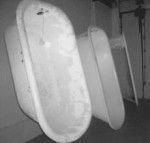Utica’s Sculpture Space Challenges Ideas About Art

Here are some simple laws of nature: a bathtub is used for bathing, hamster wheels are hamster-sized and made only for hamsters and dinosaurs certainly did not wear tutus. Recently, however, an art exhibit in nearby Utica challenged these fundamental social constructs and forced people to rethink their ideas about what constitutes art.
During the Outreach program in late August, a group of Colgate students traveled to Sculpture Space in downtown Utica to volunteer their time. The students did not know what they were getting themselves into. The name of the building, “Sculpture Space,” may evoke images of flowered gardens and Romanesque artwork, but the reality is a rundown, oversized warehouse. The only landscaping was the overgrown weeds snaking around the cinderblock, and the only decorative art seemed to be the rusty bathtubs that curiously hung from the ceilings. After this initial shock, it barely took a second to truly appreciate what a unique opportunity Sculpture Space provided.
“Each year, Sculpture Space receives 178 applications for 20 slots. The accepted artists receive a grant to reside in Utica for two months in order to concentrate fully on their artwork,” said Sydney Waller, the executive director of Sculpture Space, speaking Friday at a the Behind-the-Scenes Gala. Business and private donations enable Sculpture Space to cover the rent and studio time of three artists simultaneously. As part of the “Go Back,” days for Outreach, five Colgate students returned to Sculpture Space to celebrate the unveiling of new pieces by the three current artists: Diana Al’hadid, Abe Ferraro and Ray Nuefeld. Outreachers had helped create a portion of the artwork included in each of these artists’ collections by bending metal and scrubbing bathtubs. These artists have award-winning reputations, and have displayed their exceptional work in diverse locations ranging from Seoul, Korea to New York, NY.
The pieces on display at the gala vary and reflect each artist’s style. Diana Al’Hadid revealed a new piece that will be displayed at DePauw University in Indiana. The massive sculpture represents a metal outline of the landmass Pangaea, and is supported by a dozen baroque columns, each crumbling “under the weight of the world,” says Al’Hadid.
Beneath each column is a plaster reproduction on Muslim rugs; a tragic dinosaur lies in the midst of this destruction, strangely wearing a tutu. At the other end of the spectrum, performance artist Abe Ferraro constantly climbs a rotating climbing wall that resembles an inside-out hamster wheel. The moving sculpture, which creates a drawing via wires that are attached to Abe’s hands and feet, is symbolic of the frustration and futility of being an artist.
Alongside Abe, Ray Nuefeld explains the inspiration behind his corroded, suspended bath tubs. “After reading Moby Dick, I became fascinated with the concept of obsession,” Nuefeld remarked. In fact, one of his obsessions is bathtubs. To tie together his fascinations with Moby Dick and bathtubs, Nuefeld considered transcribing the entire text of the novel onto six bathtubs. Fortunately for his hand, Ray instead decided to project sections of the text onto the floor between the exhibit’s large hovering bathtubs.
Although these sculptures may at first seem strange, speaking with the artists revealed their deliberation and ingenuity. Next time you see an ordinary object on display in an art gallery refrain from thinking “I could have done that” or “Is that really art?” Behind each simplistic or unusual piece of art there is a story and a vision. Next time you see a precarious, three-foot-tall condiment structure on display at the Coop, don’t judge. It means something.






